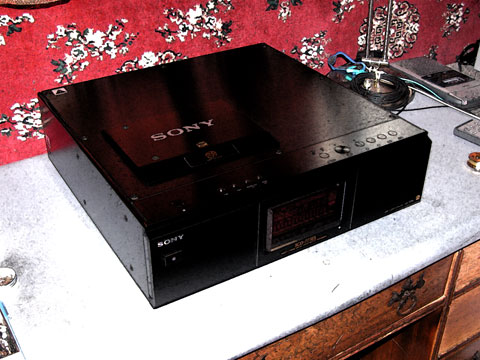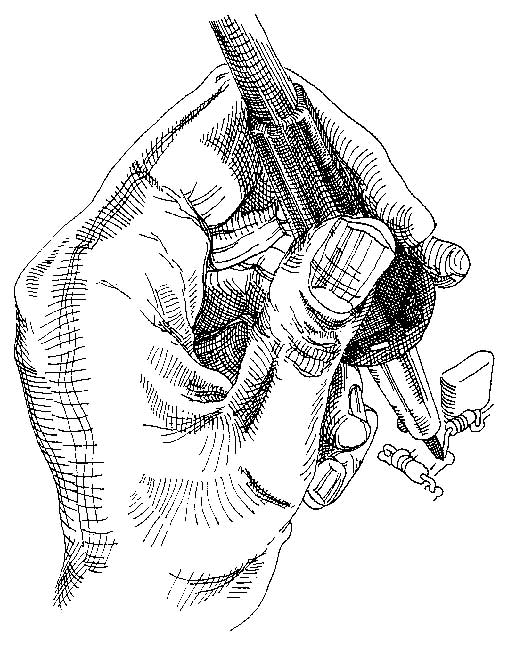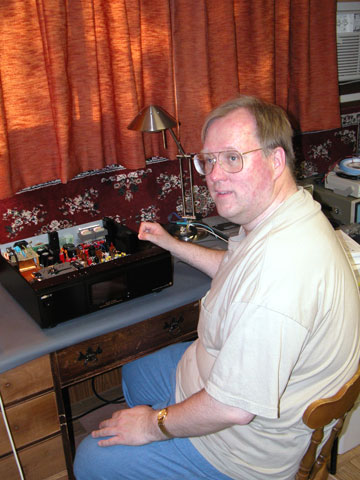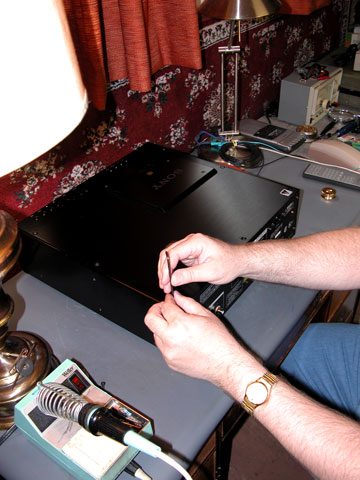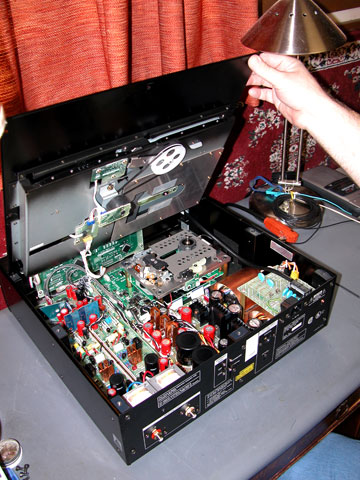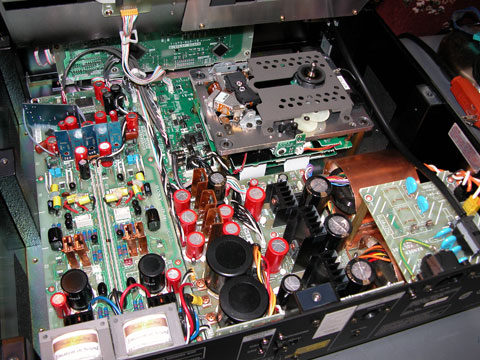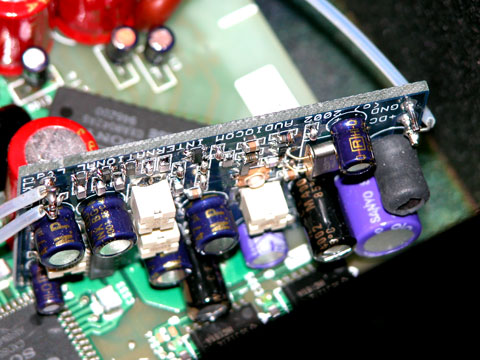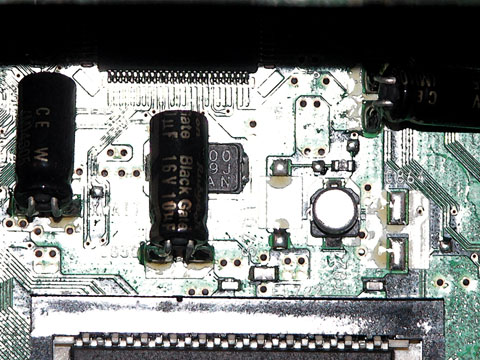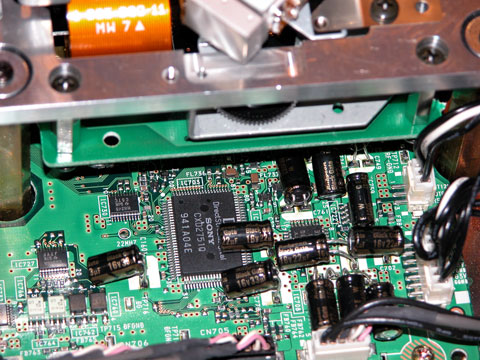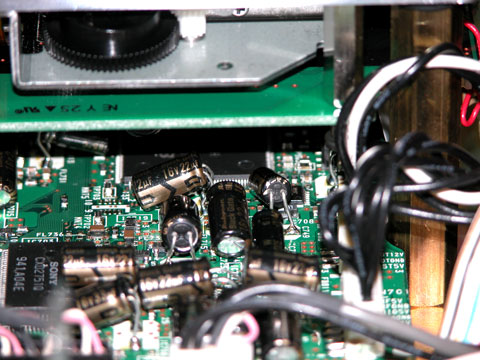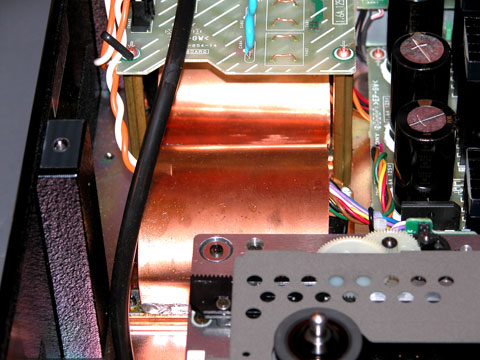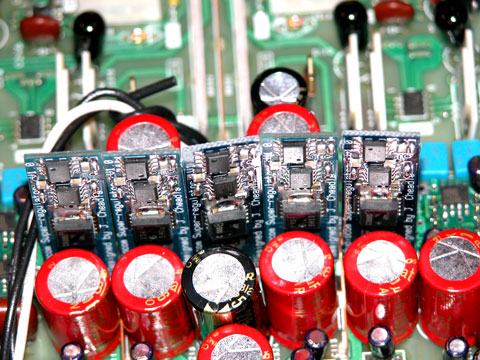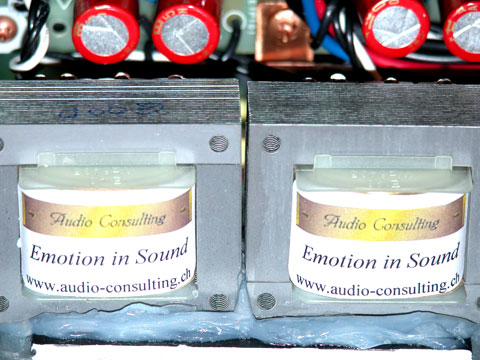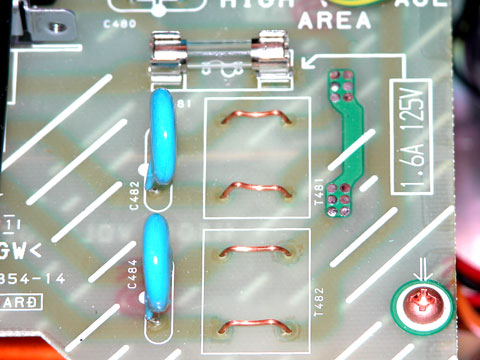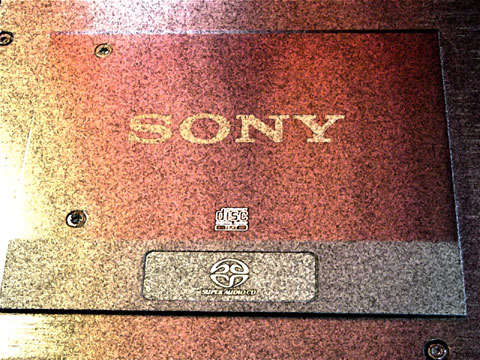|
You are reading the older HTML site
Positive Feedback ISSUE
15
"I Don't Drive Stock!" - A Photo Essay: The Audiomod
Sony SCD-777ES transport mods
(Caption commentary and company philosophy at the end of this review by Richard Kern) All photographs, image processing and frescoes by Robinson Modding/Hot-rodding redux It's been a while since I re-visited SACD mods on Sony transports. Since that time (PFO issues 1, 2, 3, 4 and 6... check the archives at www.positive-feedback.com/archives.htm) a handful of other modders and hotrodders have either gotten into the game, or have extended their modifications on SACD transports. Superior reference-grade designs like the EMM Labs DAC6 and the new EMM Labs CDSD transport have set the bar higher that it was two years ago. The modifiers—people like Allen Wright, Richard Kern, and Dan Wright—have responded by pushing their work to another level, which is a good thing for everyone.
The Sony SCD-777ES, modified by Audiomod (fresco by Robinson). Having gone through a number of mods to my SCD-1, I finally sold that unit in 2003. It was replaced by an EMM Labs DAC6 and Meitnerized Philips SACD 1000. This combination has been way ahead of any other SACD system that I've listened to in my room, and continues to be my reference for what's possible in digital reproduction... including Red Book CD playback. But I've never lost interest in the work of SACD modifiers. Back in the spring time, a debate about the qualities of modded SACD players arose on Audio Asylum's Hi-Rez Highway (www.audioasylum.com/forums/hirez/bbs.html), one of the few audio chat zones that I tune in to. Participants there wanted a profile of the various modifications that were mentioned, but the logistics of such a project were uncertain, and the requisite experience with both stock and modified players is in relatively limited supply. After thinking about it for a bit, I volunteered to evaluate any modded units that these firms wanted to send me. I got three responses, which eventually led to two units being sent my way: one from Audiomod (Richard Kern), and one from Vacuum State Electronics, Inc. (Allen Wright and company). The first of the two is the subject of this profile; Allen's work will be the focus of a later article.
The Audiomod Sony SCD-777ES I know Richard Kern very well; he's the hot-rodder who worked on my SCD-1 through a series of modifications described in the set of PFO articles listed above. Richard lives all of about 15 minutes from PFO Central here in River City; I've lugged the SCD-1 back and forth to his house on a number of occasions. He is a meticulous craftsman, who knows his way about the Sony SCD-1 and 777 very well indeed. I have no idea how many people have gone to him for modifications, but I do know that his shop is usually filled with a number of boxes from clients all over the world. His reputation is first-rate, with quick turnarounds and excellent workmanship being his trademark.
Richard Kern at the workbench with the Sony SCD-777ES evaluated in this review. When Richard responded on AA that he would be willing to send a unit with many of his latest mods, I immediately took him up on the offer. As it turned out, he had modded a 777 for submission. I knew Richard's skill with the SCD-1, but had never heard a 777 that he had modified. The stock 777 is an SACD player that I've always considered to be somewhat problematic. Despite the fact that some at Sony claimed it was an SCD-1 without the balanced outputs and thus roughly equivalent, it was never anything of the sort to my ears. In my opinion, the 777 lacks the sense of extension and transparency that's native to the SCD-1 in its unbalanced, 100kHz mode ("Custom" setting on the output). Even when broken in, every stock 777 that I've ever heard sounds rather dark in its tonal balance. (Some would say "rich" or "musical"... I would say "dark," and "less detailed." C'est le gout.) Could Richard Kern's mods make a significant change in the signature sound of the stock 777?
Kern opening the lid of the 777...
...and exposing the interior of the beastie. The arrival This was easy—I just drove over to Richard's place. (Having both Richard and Dan Wright of ModWright within easy driving distance here in Portland certainly makes these projects easy to do.) Included with the Audiomod 777 were a pair of unbalanced analog interconnects called "The Reverie" from WHG Audio Design ($1249 per meter pair) that Richard particularly favored with his design, and that he asked me to try. All listening during this review was done using the WHG Audio Design interconnects. The mods that Richard installed in this particular 777 included the following list of parts and prices that he sent along to me: 1. Transport Cap Mod - $100 parts, $200 labor. 2. Super Clock 2 - $277 parts, $100 labor. 3. Audio Board Black Gate Cap Mod - $370 parts, $150 labor. 4. Audio Board Vishay Resistor Mod - $168 parts, $60 labor. (Note: This is not the full mod. Only 14 out of 42 resistors are changed. The full mod costs $475 parts and $150 labor.) 5. Audio Output Transformer Mod - $440 parts, $200 labor. (Customers can install RAM's best transformer for $900 parts and $200 labor.) 6. Audio Board Regulators - $330 parts, $100 labor. 7. Audio Board OP Amps - $233 parts, $75 labor. 8. Power Supply Board Black Gate Cap Mod - $412 parts, $100 labor. 9. Power Supply Board Regulators - $200 parts, $100 labor. 10. Power Transformer Shielding - $20 parts, $60 labor. 11. Removing the AC Power Line Filter in the Sony. N/C (Note: Customer must have external line filter or I will not remove this filter.) Check the Reference Audio Mods web site (www.referenceaudiomods.com/Merchant2/merchant.mvc?Screen=CTGY&Store_Code=RAM&Category_Code=MODS) for additional mods for this player.
Looking at the modded 777 interior from the rear. I placed the Audiomod player on an Extemephono platform, and inserted a Kimber Palladium power cable, an exceptional product that I know to be just slightly to the warm side of neutral in my system. After allowing the 777 to warm up for several days, I sat down to listen. The Sound Certainly, one thing was apparent from the get-go: Richard Kern has cured the 777 of its "darkness." Instead of being somewhat warm and rich, the Audiomod 777 was a noticeably more extended creature. I've never cared for any playback system (CD is a particular offender here) that makes me feel like my head is just outside of a venue... standing outside the room, listening to rolled-off sound. The baseline 777 was nowhere near the worst that I've heard, but it could be an awful lot better. I'm glad to say that there was a much better sense of air and presence in the Audiomod 777 than in the stock, an immediately discernable gain in clarity. Tonally, instead of being warm, I would say that the sound had shifted to a very attractive silkiness... distantly reminiscent of the Marantz SA-1... but with a more energetic presentation, a more forward framework for listening. Marantz fans will definitely like this modded player, I think.
The Audiocom Superclock II; Richard Kern considers this to be the best after-market clock made. Detail and texture was greatly improved over stock, but this was no surprise: in my experience, you simply cannot drop an Audiocom Superclock II into a Sony without getting very substantial improvements in this area. Instead of the dark gloss of the stock 777, there is a gratifying emergence of recorded detail, of the contours of a recorded event. You know when this is happening any time you hear listeners respond with variations of "I never noticed that before!" or "Did you hear that?!" As I've noted in previous reviews of the Superclock II, the improved resolution and lower jitter of the Superclock II results in significant increases in imaging specificity, almost as though you were getting the focus more definitely right on a telescope. Finding things in your mind's eye is easier, because the presentation is clearer, and front-to-back layers (particularly in the better orchestral stereo recordings) become more evident. The 777 in question shared the sort of great Superclock II resolution that I heard in my modded SCD-1.
Auricaps on parade; Kern comments that "Auri caps are used in the low-pass filter section because of their high quality and neutral sounding tonality." Furthermore, the stock capacitors, power regulators, opamps and power supplies get in the way of the possibilities of the playback signal. Kern spends very serious amounts of time and effort removing component egregiousness and adding high quality parts to the circuitry. Unfortunately, unlike earlier Audiomod SCD-1 review projects, where I took each modification package one at a time, broke it in, and then assessed it before going on to the next step, I had to review the 777's mods as a fait accompli—a single package all at once. I do know that each upgrade group makes its own contribution to the improvements... see my earlier "I Don't Drive Stock!" series of articles for the specifics... but cannot break the audio dimensions out precisely in this unit. Use my earlier writings as a general guide here.
A close-up photo fresco of two Black Gate caps used in Audiomod's transport upgrade; Kern notes, "In total, 58 caps are installed in this mod."
After modification, the Decoder board near the 777 transport sprouts a set of Black Gate capacitors.
A closer look at the Black Gates near the transport section; Kern observes that we are not seeing "... the RF board where more caps are installed." Richard also paid attention to the power supply of the 777. Additional copper TI shielding was installed to prevent nasties from creeping into the system. There is a very pleasant freedom from hash in the sound of the Audiomod 777; some of it comes from the Superclock II and the better caps and the better resistors, but I'd not be surprised if the improved shielding isn't helping out here. Richard thinks that it does. I should also mention that, like the imaging, the soundstaging of the modded 777 is somewhat wider and deeper than the stock 777. Stock sounds rather closed in and "boxy"; the Kerned 777 blooms nicely, and lets SACDs give you a much better sense of locale. Audio claustrophobia can take a hike; the Audiomod 777 is a breathing creature!
The installed copper shielding; Kern says "Each power transformer is shielded with TI shield, a metal composite of copper and steel. Shielding the transformers gives the sound a more open quality."
A close-up view of the Audiocom power regulators in place; Kern notes, "This is a shot of five Audiocom Super Regulators used in the Digital Section of the Sony. These Regulators greatly improve the power supply bandwidth, while reducing the noise floor. The sonic result is a faster more detailed sound, with more openness in the soundstage." I can vouch for the improvement in soundstaging that Richard mentions, though I attribute this in part to the Superclock II.
Richard Kern used Audio Consulting output transformers in this particular 777; those wishing to take the output trannies to a higher level can step up to the more expensive RAM trannies. Kern says of this photo, "Audio Consulting Transformers are used to bypass most of the Sony's analog section for better transparency. These transformers have high purity silver wiring and are flat to 100kHz."
In the category of "there's no ‘there', there!" Kern does a filterectomy on the 777, and comments, "This is a shot of the removed stock RF filters in the Sony's AC supply. If you have a good after-market AC filter box, the Sony's stock filters can be removed for better sound." Conclusion Once again, I find that Richard Kern has done a masterful job of bringing great things out of the implicit possibilities of an SACD player. A stock 777 is not a good place to end up... you won't be hearing everything that SACD and CD playback could be... but it is a very good platform for a hot-rodder to start with.
Which mods should you do on your 777? Only you know your budget and preferences, but I can say that, at a bare minimum, you must do the Superclock II, the transport caps mod, and the audio board Black Gate and Vishay mods. After that, I would do the opamps and the regulators; the rest as I could afford it, after conferring with Richard Kern about audio priorities. Overall, I would say that Richard Kern has done remarkable work in greatly improving the audio character of the 777. Under Kern's expert hand, the 777 is no longer darkish and constricted; instead, it projects a silky, detailed, clear exposition of audio signal that makes listening to both SACDs and CD a real pleasure. At this price point, Audiomod has delivered a remarkable degree of bang for the buck... no doubt about it. Anyone with a 777 in hand, and having a budget of $2500 - $4000 for modifications, really needs to give serious consideration to having Audiomod work some serious magic on their machine. Finally—since I get asked this question about every SACD player I review—is the Audiomod 777 a "Meitner Killer"? Has it finally outpointed my reference EMM Labs DAC6/Philips 1000 combo. In a word: "nope." I'd be the first to say so if it did so, but EMM Labs continues to set the standard in about every category. To Richard Kern's credit, his new transport mod does close the gap with the Meitner gear somewhat (though I expect the gap to increase... perhaps very significantly... when the EMM Labs CDSD transport arrives here in the near future), but extended A/B listening comparisons via the EMM Labs SWM3 preamp made it clear that the reign of the EMM Labs DAC6 continues, undisturbed. Price of the modified player in this review: $4000 (Please consult the price list in this article or Audiomod for a quotation on your SACD/CD platform) For more information:
Richard Kern For more information about WHG Audio Design cables: "The Reverie" unbalanced interconnects, 1.0 meter, $1249
William Greb P.S. A clarification about Audiomod and Reference Audio Mods (RAM) During our discussion, Richard made a point about Audiomod that readers of PFO need to be aware of. While he sources many of his parts from Reference Audio Mods (RAM) (www.referenceaudiomods.com), they are not the same firm. (It probably doesn't help that Audiocom International supplies some of the parts to Reference Audio Mods, which in turn supply Audiomod. Lost yet?) You can source modifications at RAM (www.referenceaudiomods.com/Merchant2/merchant.mvc?Screen=CTGY&Store_Code=RAM&Category_Code=MODS), and arrange their shipment to Richard... but they are two different companies.
My company philosophy - Richard Kern Audiomod offers SACD player modification packages to our customers for units that I have owned or modified in the past. I can also modify new equipment at cost. This saves me the cost of buying the equipment. Audiomod's approach to modification is simple and direct. First, I analyze the product to search out its strengths and weaknesses. I never modify a product just to modify it. If the product (in my opinion) needs no modifications, no modifications will be done. Second, after studying the modification possibilities for the unit I will (if cost permits) modify the unit as far as I can. Third, I break the modification into several packages so my customers can choose the packages they can afford. Over time, new technologies permit me to offer updated modification packages for the units I modify. When I analyze a player for modification, I never start with any preconceived notions as to where I should begin to modify. Some modifiers will look at a product and immediately bypass or modify the analog section. I disagree with this approach. Modern players spread the engineering compromises through out the entire product. I have never seen a perfect transport, power supply and digital section in any product, so why blame the product's shortcomings on its analog section alone. When designing new modifications, I will not modify "the machine of the month." In other words, I won't modify a product just because every other modifier is doing it. Since my overhead is low, I can choose the players I wish to modify based on the quality of the original design, the reliability of the design, and the modification possibilities of that design. I try to choose products that will yield a large sonic improvement when modified. Any product that fails to live up to these goals will be dropped from my list. Because modifications will void the manufacturer's warranty, I only modify products from manufacturers who can provide parts and service manuals. If I can't obtain parts for a player, I will drop it from my line. One last note: My customers routinely ask me to recommend SACD players for them to purchase, and this question always comes up: are the Sony SCD-1 and SCD-777ES still worth modifying? The answer is YES. Sony designed these players to be the best, and even though they can be beaten in stock form, once modified these players are some of the best values in audio today.
Richard Kern
|

